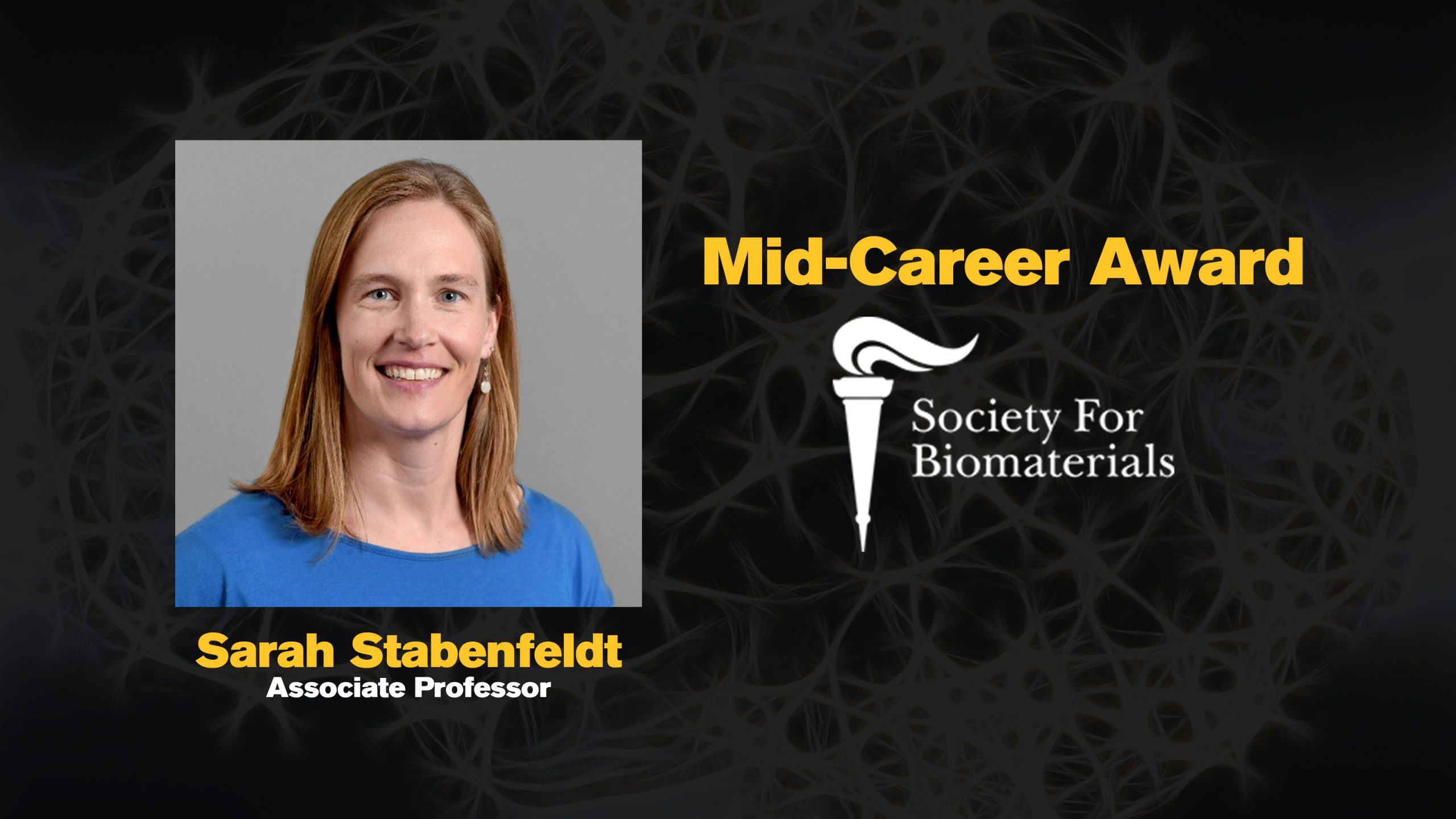
Stabenfeldt receives Society For Biomaterials Mid-Career Award

Associate Professor Sarah Stabenfeldt was recently recognized with the Mid-Career Award from the Society For Biomaterials at the organization’s 2021 virtual annual meeting, held from April 20–23.
This award recognizes researchers and community members who are in the middle of their careers and have made outstanding contributions to the society and to the field of biomaterials.
Stabenfeldt has been an active member and leader in the Society For Biomaterials for more than 16 years. She has served as the Special Interest Group representative to the Society For Biomaterials Council and on the Board of Directors as secretary-treasurer elect, as secretary-treasurer (current role) and as a member of the diversity, equity and inclusion task force.
“To me, this award represents the contributions of my students and trainees. It highlights all the hard work they have done to contribute to biomaterials research,” Stabenfeldt says. “I had strong female researcher role models who provided support to me and ultimately contributed my achievements thus far. I try to pay it forward and continue to mentor and train a diverse lab.”
The Stabenfeldt Lab at ASU focuses on biomaterials for neurotrauma, particularly traumatic brain injuries.
“We’re essentially utilizing biomaterials to develop novel therapeutics and diagnostics for traumatic brain injury,” Stabenfeldt says. “We employ a range of strategies including nanoparticle drug delivery to hydrogel systems for tissue engineering.”
One of her projects, which received $2.5 million in funding from the National Institutes of Health, focuses on understanding sex-based differences in traumatic brain injuries to help design more effective treatments.
“Looking at male versus female in biomedical studies may sound straightforward, but it’s typically not,” Stabenfeldt says. “We’re starting to understand and embrace some of the complexity of biological variables and working towards integrating biological considerations into biomaterial research.”
In recent years, the NIH has mandated the explicit explanation of how biological variables are considered, including in experimental designs. As a result, more preclinical studies now include and are possibly even designed to evaluate sex as an independent variable.
“Historically, neurotrauma research mainly used male subjects to minimize hormonal variations associated with the female menstrual cycle. Depending on the experimental design, researchers may need to account for different hormone levels,” Stabenfeldt says. “So, the differences between males and females have previously been understudied. This issue is not specific to neurotrauma, but broader biomedical research as there have been a number of issues in terms of drug developments and medical approaches where the response in females was not adequately investigated prior to translating to the clinic.”
Stabenfeldt and her team have noted a difference in the blood-brain barrier disruption between males and females in different phases after traumatic brain injury. If this trend holds true in clinical scenarios, then differing pharmacological dosing levels would be needed depending on the sex of the patient.
This work is crucial to bringing diversity into health care research and has the potential to improve treatments for traumatic brain injuries in females.
Stabenfeldt is committed to diversity both in terms of her contributions to the biomedical field and to her goal to “understand and embrace the complexity of biological variables” as well as to build a diverse lab.
“One of the pillars of my lab is to make sure that everybody feels welcome, supported, and can be themselves regardless of gender identity, race, ethnicity and sexual orientation,” Stabenfeldt says. “That’s how we can build a strong and innovative next generation of scientists.”
“This award recognizes the tremendous contributions of Dr. Stabenfeldt to the biomaterials community through both her exceptional research program and leadership in the Society for Biomaterials,” says Elizabeth Cosgriff-Hernández, a professor at the University of Texas at Austin and Stabenfeldt’s nominator for the award. “She is a leader in neural tissue engineering and regenerative medicine and has built an incredible research program focused on developing biomaterials-based therapeutics and diagnostics for acute neural injury.”
“I want to recognize that not everyone in science receives the immense support and mentorship that I have had the fortune of receiving in my career,” Stabenfeldt says. “We, the scientific community and academics, need to address the inequities in STEM and recognize disparities in funding and support that scholars from historically marginalized groups experience. Our scientific community should lift folks up, not tear them down.”



































